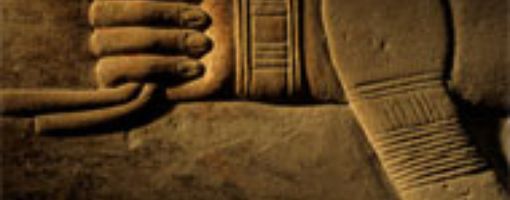THE NEW KINGDOM

The New Kingdom, which dates from about 1580 B.C., signaled the triumphof Egyptians arms over the whole of the then known world. It was a period ofmilitary power based not on defense but on conquest. It was also a periodof great artistic achievement and of cultural activity in general. Thebeswas still the capital and the priests of Amon were more influential than ever.Ahmose's immediate successors, Tutmose I and Tutmose II, devoted theirreigns mainly to military expeditions and conquest. Queen Hatshepsut on theother hand was less war-like. She declared herself regent after removingher nephew Tutmose III and reigned alone for twenty two years, wearing a beardand male attire. Her reign, very quiet as far military activity was concerned,was characterized by frantic activity in the artistic sphere and in particularby the construction of the architectural master-piece constituted by thefunerary complex at Deir-el-Bahari.
Atthe death of this aunt Tutmose III regained the throne and had the name of theusurper erased from all her monuments. His 34 year reign turned out to be one ofthe most splendid periods of Egyptian history. By means of seventeen militarycampaigns in Asia he defeated the Mitans conclusively. His victories at Megiddo,Kark-hemish and Kadesh are famous. Toward the end of his reign Tutmose IIIreached the fourth cataract so that Egypt stretched from Napata in Nubia, nowGebel Barkal, to the river Euphrates. In 1372 B.C. Amon Ofis IV ascended thethrone. He has gone down in history as the poet-king and also as theheretical or schismatic king. Frightened by the power of the priests ofAmon who had succeeded in creating a state within a state he substituted theworship of Aton, the solar disc, for that of Amon.
This new cult did not require the use of images so he closed the templesand dispersed the clergy. He also abandoned Thebes and founded a newcapital Akhet-Aton, « the horizon of Aton », now called Tell el-Amarna. Hisfinal act was to change his own name from Amon-Ofis, which means « Amon ispleased », to Akhen-At on, which means « this pleases Aton».
The religious change however did not survive him. The crown passed to thevery young Tut-Ankh-Aton who under the influence of the beautiful Nefertiti, «the beautiful one who comes », wife-sister of Akhenaton, returned to Thebesafter a short while, revived the cult of Amon and changed his own name toTutankhamen. This king who died mysteriously at the age of eighteen has passedinto history because of the fascinating story of the discovery of his tomb in1922 by Howard Carter. Egypt then fell into a state of anarchy and thenceinto the hands of military rulers: Horemheb, Ramses I, a professional soldier,Seti I who revived the policy of conquest to the east, and finally RamsesII, known as Ramses the Great, who engaged all his forces in order todefeat the armies of the Hittites. They were in fact stopped at Kadesh after anepic battle of doubtful outcome which had no real victors or vanquished.During his seventy seven year reign he enjoyed demonstrating his great power bybuilding colossal monuments e.g. Abu Simbel, Karnak and Luxor. On his death hewas succeeded by his son Mineptah. Internal anarchy together with the arrivaltowards the end of the second millennium B.C. of Indo-European peoples in Libya,Asia and the whole of the Mediterranean basin destroyed an already precariousequilibrium. The Third Interim Period started in 1085 B.C. with theadvent of the XXIst dynasty when the capital, was at Tanis. The succeedingdynasty saw power first in the hands of a Libyan King and later in the hands ofan Ethiopian king, the capital being moved to Nepatat in the Sudan. This wasfollowed by the Saitian-Persian period. In 524 B.C. during the XVIIth dynastythe Persians under Cambyses conquered Egypt for the first time. In 332 B.C.the Egyptians called on Alexander the Great to help them and he wasacclaimed as a Liberator. Declared « a son of Ra » by the oracle of Luxor hefunded the new city of Alexandria (he was buried there in 323 B.C.) whichrapidly became the cultural capital of the whole of the ancient world. His deathmarked the beginning of the Ptolemaic or lagidan dynasty which started theHelleni-sation of the country. During the two centuries preceding the birthof Christ, Egypt became progressively weaker compared with Rome of which iteventually became a colony. Finally at the death of Theodosius in 595 A.D.Egypt became a part of the EasternEmpire.
Your Rating:
Overall rating: 0.000
Totally voted: 0
Comments
Weather in:
Exchange Rates
-
IMF loan expected next month
Apr 22, 2013, rating: 3.000, 3 votes Egypt may secure an International Monetary Fund loan agreement in about amonth, state news agency MENA reported, quoting "informed" sources ...
Egypt may secure an International Monetary Fund loan agreement in about amonth, state news agency MENA reported, quoting "informed" sources ...
-
Egypt received 11 million tourists in 2012 and aims to boost that number to 14 million in 2013.
Jan 22, 2013, rating: 3.000, 2 votes
Egypt received 11 million tourists in 2012 and aims to boost that number to 14 million in 2013.
-
Egypt limits travelers leaving country to US$10,000 in cash
Dec 26, 2012, rating: 3.250, 4 votes Egypt has banned travelers from carrying more than US$10,000 in foreigncurrency cash in or out of the country ...
Egypt has banned travelers from carrying more than US$10,000 in foreigncurrency cash in or out of the country ...
-
National Coalition on Climate Change for Egypt is born
Nov 30, 2012, rating: 5.000, 1 votes The global COP18 conference on climate change opens in Doha Monday.About 17,000 participants from all over the world ...
The global COP18 conference on climate change opens in Doha Monday.About 17,000 participants from all over the world ...
-
Egyptian family's average annual income is LE25,000, agency reports.
Nov 29, 2012, rating: 5.000, 1 votes The average annual Egyptian household income during 2010-2011 wasLE25,353, according to the Central Agency for Public Mobilization andStatistics.
The average annual Egyptian household income during 2010-2011 wasLE25,353, according to the Central Agency for Public Mobilization andStatistics.
-
Judgment for sexual harassment
Nov 14, 2012, rating: 3.600, 5 votes A man was sentenced to two years in prison and fined LE 2,000 for sexually harassing a woman, an ...
A man was sentenced to two years in prison and fined LE 2,000 for sexually harassing a woman, an ...








